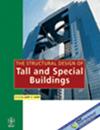采用混合质量阻尼器的实际高层塔的鲁棒结构控制
IF 1.3
3区 工程技术
Q3 CONSTRUCTION & BUILDING TECHNOLOGY
引用次数: 7
摘要
在本文中,使用结构控制领域最新提出的鲁棒模型预测控制方案(RMPC),对实际高层塔楼的鲁棒控制进行了研究。设计了两个RMPC控制器,考虑位移缓解(RMPC1)或功耗效率(RMPC2)。将这两种控制器与基准鲁棒性H∞控制方案进行了比较,以证明它们的相对性能。基于对相关文献的广泛研究,设计了许多刚度和阻尼不确定性场景,以估计三个控制器中每个控制器的鲁棒性。在所有情况下,引入了±5%的可变执行器不确定性。研究发现,所有控制器都能有效地控制塔架,并表现出对参数和执行器不确定性的鲁棒性,具有不同的相对优势。例如,当考虑均方根(RMS)和峰值位移和加速度降低时,H∞的平均性能降低了24%,RMPC1降低了31%,RMPC2降低了28%。本文章由计算机程序翻译,如有差异,请以英文原文为准。
Robust structural control of a real high‐rise tower equipped with a hybrid mass damper
In this paper, the robust control of a real high‐rise tower is studied, using a newly proposed, in the structural control field, Robust Model Predictive Control scheme (RMPC). Two RMPC controllers were designed considering either displacement mitigation (RMPC1) or power consumption efficiency (RMPC2). The two controllers were compared to the benchmark, robustness‐wise, H∞ control scheme to demonstrate their relative performance. A number of stiffness and damping uncertainty scenarios were designed based on a broad study of the relevant literature, in order to estimate the robustness of each of the three controllers. In all scenarios, variable actuator uncertainty of ±5% was introduced. It was found that all controllers are effective in controlling the tower and demonstrate robustness against parametric and actuator uncertainties with different relative merits over each other. Indicatively, when considering root‐mean‐square (RMS) and peak displacement and acceleration reduction, the H∞ had an average performance reduction of 24%, the RMPC1 31% and the RMPC2 28% against their uncontrolled equivalent.
求助全文
通过发布文献求助,成功后即可免费获取论文全文。
去求助
来源期刊
CiteScore
5.30
自引率
4.20%
发文量
83
审稿时长
6-12 weeks
期刊介绍:
The Structural Design of Tall and Special Buildings provides structural engineers and contractors with a detailed written presentation of innovative structural engineering and construction practices for tall and special buildings. It also presents applied research on new materials or analysis methods that can directly benefit structural engineers involved in the design of tall and special buildings. The editor''s policy is to maintain a reasonable balance between papers from design engineers and from research workers so that the Journal will be useful to both groups. The problems in this field and their solutions are international in character and require a knowledge of several traditional disciplines and the Journal will reflect this.
The main subject of the Journal is the structural design and construction of tall and special buildings. The basic definition of a tall building, in the context of the Journal audience, is a structure that is equal to or greater than 50 meters (165 feet) in height, or 14 stories or greater. A special building is one with unique architectural or structural characteristics.
However, manuscripts dealing with chimneys, water towers, silos, cooling towers, and pools will generally not be considered for review. The journal will present papers on new innovative structural systems, materials and methods of analysis.

 求助内容:
求助内容: 应助结果提醒方式:
应助结果提醒方式:


